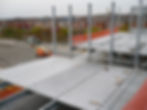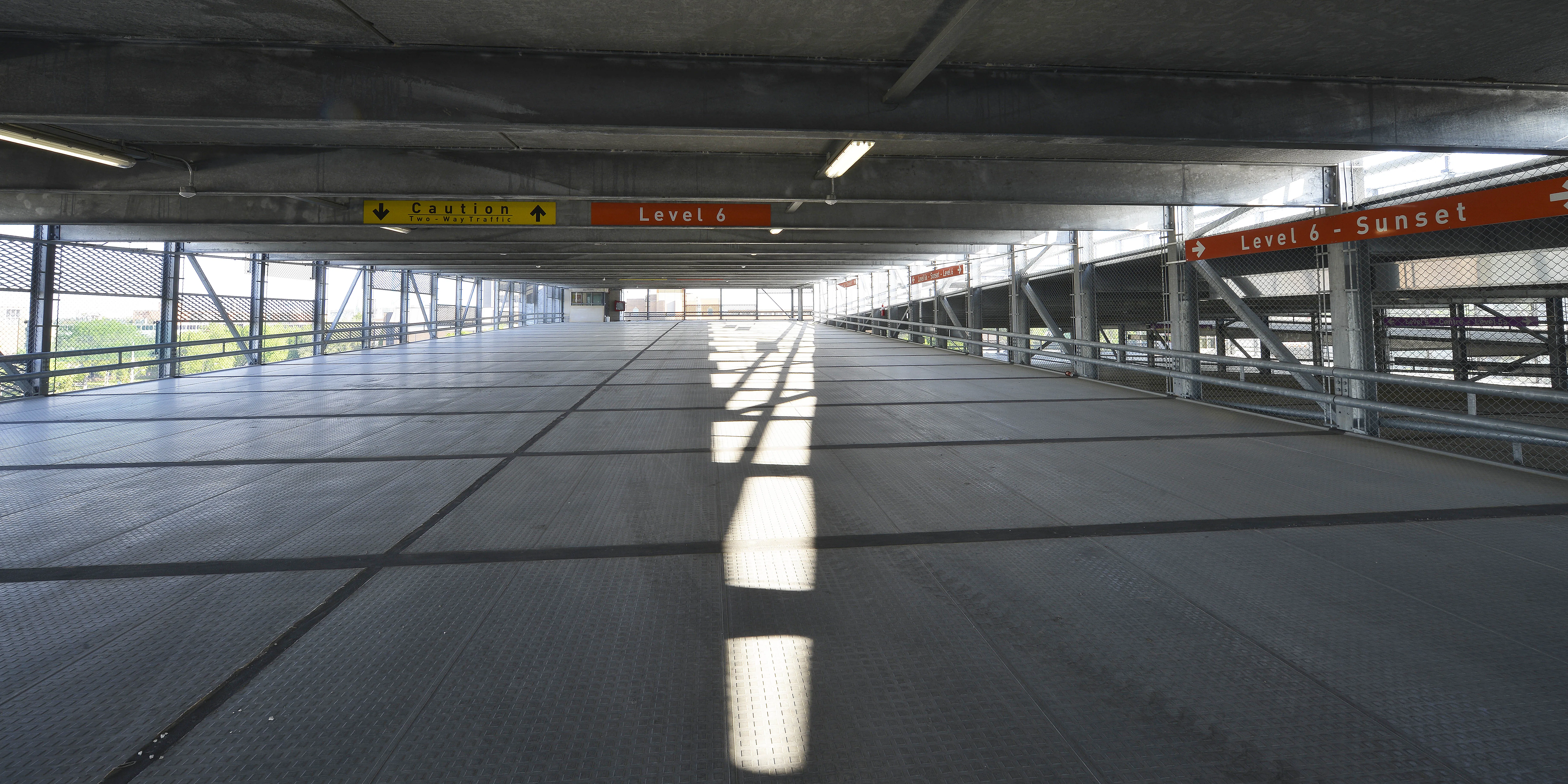Imagine concrete that's not only incredibly strong, but also thin, sleek, and built to last for decades. This isn't science fiction - it's the reality of Ultra-High Performance Concrete (UHPC).
What is Ultra-High Performance Concrete (UHPC)?
Ultra-High Performance Concrete (UHPC) is a significant advancement in concrete technology.
It offers superior properties compared to traditional concrete, making it a valuable option for various construction applications.
UHPC boasts exceptional strength, exceeding traditional concrete by 5-10 times.
This allows for thinner elements in structural design while maintaining load-bearing capacity. Additionally, UHPC offers remarkable durability, resisting cracking, freeze-thaw cycles, and harsh chemicals.
This translates to a longer lifespan for structures and potentially reduced maintenance needs.
Benefits of UHPC for Construction: Redefining Efficiency and Performance
Ultra-High Performance Concrete (UHPC) offers a compelling set of advantages for the construction industry, pushing the boundaries of what's possible. Here's a closer look at the key benefits UHPC brings to various construction projects.
Enhanced Structural Efficiency
UHPC's exceptional strength allows for thinner elements in structural design. This translates to lighter weight structures, reduced material usage, and potentially smaller foundation requirements. This efficiency can lead to cost savings and optimized use of space.
Superior Durability
Compared to traditional concrete, UHPC exhibits remarkable resistance to cracking, freeze-thaw cycles, de-icing salts, and other aggressive chemicals.
This translates to a longer lifespan for structures, reduced maintenance needs over time, and potentially lower life-cycle costs.
Design Flexibility and Aesthetics
UHPC's superior workability allows for the creation of intricate shapes and architectural details that are difficult to achieve with traditional concrete.
This design flexibility opens doors for architects and engineers to create visually striking and innovative structures.
Additionally, UHPC's smooth, high-quality finish enhances the aesthetics of architectural elements.
Potential for Prefabrication
UHPC's suitability for prefabrication offers several advantages.
Prefabricated UHPC components can be produced in a controlled environment, ensuring consistent quality and reducing construction time on-site.
This can lead to improved project schedules and potentially lower labor costs.

Sustainability Considerations
While the upfront cost of UHPC per cubic meter might be slightly higher than traditional concrete, its exceptional durability can lead to lower life-cycle costs due to reduced maintenance needs and potentially extended lifespan.
Additionally, UHPC's ability to optimize material usage and potentially reduce construction traffic emissions contributes to a more sustainable construction approach.
Embodied Carbon
An often-overlooked factor is embodied carbon.
Embodied carbon refers to the sum of all the greenhouse gas emissions attributed to a material throughout its life cycle, from material extraction and processing to transportation and construction.
UHPC's ability to optimize structural design can lead to a reduction in the total amount of material required for a project.
Furthermore, the potential for prefabrication can minimize construction traffic, further reducing embodied carbon emissions.
Overall, UHPC presents a unique opportunity for the construction industry. Its exceptional strength, durability, design flexibility, and potential for prefabrication offer significant advantages for a wide range of projects.
As UHPC technology continues to evolve and production costs become more competitive, its adoption is expected to grow, transforming the way we design and build structures in a more sustainable manner.
Brief History of Ultra-High Performance Concrete (UHPC)
Ultra-High Performance Concrete (UHPC) isn't a completely new invention. It represents the culmination of centuries of advancements in cementitious materials. Let's delve into the historical journey that led to UHPC:
Ancient Origins (3000 BC - 476 AD)
The use of cementitious materials dates back to ancient civilizations like the Egyptians and Romans. These early materials, primarily lime-based, laid the foundation for future developments in concrete technology.
1824: A Pivotal Year
The invention of Portland cement by Joseph Aspdin is a significant milestone.
This hydraulic cement, when mixed with water and aggregates, forms the basis for modern concrete.
Mid-1800s: The Rise of Reinforced Concrete
The introduction of metallic reinforcement by Joseph Monier marks a major step forward.
This composite material, combining the compressive strength of concrete with the tensile strength of steel, significantly expands the potential applications of concrete.
1980s: The Quest for High Performance
The latter half of the 20th century sees the emergence of High-Performance Concrete (HPC) and High-Strength Concrete (HSC).
These advancements focus on pushing the boundaries of concrete's strength and durability.
1994: UHPC Arrives on the Scene
The term "Ultra-High Performance Concrete" is formally introduced, signifying a new era in concrete technology with a focus on superior strength and other performance characteristics.
1997: The First UHPC Bridge
A pedestrian bridge in Sherbrooke, Canada, becomes the first structure built entirely with UHPC, showcasing the real-world potential of this innovative material.
Early 2000s: Commercial Interest
Increased focus on research and development of UHPC, with universities and private companies playing a key role in advancements.
This period saw significant improvements in UHPC mix design and production methods.
2014: UHPC in Europe
The first edition of the European Guidelines for UHPC (EFNARC) is published.
This standardization effort signifies growing international recognition and acceptance of UHPC technology.
2018: A Step Towards Wider Adoption
The Canadian Standards Association (CSA) releases a draft specification for UHPC (Annex U).
This paves the way for broader acceptance and use of UHPC in North America.
Technical Section - The Science Behind UHPC
UHPC's remarkable properties stem from a unique synergy between its optimized material composition and a meticulous production process.
This part of the article is going to get fairly technical … so you’ve been warned.
Ingredient Selection & Optimization
UHPC utilizes a specially engineered blend of cementitious materials. High-quality portland cement forms the base, but unlike traditional concrete, UHPC incorporates.
Supplementary Cementitious Materials (SCMs)
Fly ash, silica fume, or other SCMs are often added to enhance packing density, promote pozzolanic reactions for long-term strength, and improve workability.
Reactive Powders
Finely ground materials like silica sand or nano-particles are introduced to fill voids and create a denser microstructure, reducing permeability and enhancing strength.
Benefits of Less Water in UHPC
Unlike traditional concrete, UHPC boasts a significantly lower water-to-cementitious material ratio (w/cm). This is a critical factor.
A lower w/cm ratio translates to a denser, less porous microstructure with enhanced.
Compressive Strength
With less water to occupy space, more cementitious material can participate in hydration reactions, leading to a stronger and more robust matrix.
Durability
A denser microstructure offers less space for water to penetrate and freeze, improving freeze-thaw resistance.
Additionally, a lower w/cm ratio reduces permeability, hindering the ingress of aggressive chemicals.
High-Range Water Reducers (HRWRs)
These chemical admixtures play a vital role. HRWRs allow for a lower w/cm ratio while maintaining adequate workability.
They achieve this by dispersing and flocculating cement particles, improving the efficiency of water usage and enhancing the packing density of the cementitious matrix.
Production Considerations
UHPC production often involves specialized mixing techniques like high-shear mixing to ensure proper dispersion of the various ingredients and achieve a homogeneous microstructure.
Additionally, casting methods may involve vacuum casting or pressure consolidation to further eliminate air voids and achieve optimal density.
The careful selection of ingredients, meticulous control of the w/cm ratio, and the utilization of HRWRs all contribute to UHPC's exceptional properties. This synergy between material science and production techniques is what makes UHPC a revolutionary advancement in concrete technology.
UHPC Applications in Construction
UHPC's unique properties transcend its status as a high-performance material. It's a catalyst for innovation, opening doors to a wider range of applications in construction projects.
Here's a glimpse into how UHPC is transforming various construction sectors.
High-Performance Buildings
UHPC's ability to create thinner, yet stronger elements makes it ideal for high-rise buildings. This translates to increased usable floor space, reduced dead weight for efficient structural design, and potentially shorter construction times.
Additionally, UHPC's exceptional durability is well-suited for exposed architectural elements in these structures.
Bridges and Transportation Infrastructure
UHPC's superior strength and durability make it a valuable asset for bridge construction.
Thinner bridge decks, prefabricated UHPC components for faster construction, and enhanced resistance to de-icing salts and freeze-thaw cycles all contribute to longer lifespans and reduced maintenance needs for bridges.
UHPC can also be utilized for other transportation infrastructure elements like durable and lightweight traffic barriers.
Parking Structures

UHPC's potential for thinner slabs translates to more parking spaces within a building footprint or a reduction in overall building height for parking structures.
Additionally, UHPC's exceptional resistance to de-icing salts and abrasion from vehicle traffic ensures a longer lifespan for parking decks, minimizing maintenance requirements.
Seismic Zones
UHPC's enhanced ductility and strength make it a valuable material for construction in earthquake-prone areas.
Structures built with UHPC can potentially withstand seismic forces more effectively, improving overall safety and resilience.
Marine Applications
UHPC's superior resistance to chloride ingress and harsh marine environments makes it ideal for waterfront structures, piers, and seawalls.
This translates to longer-lasting and more durable marine infrastructure, reducing the need for frequent repairs and replacements.
Facade & Architectural Elements
UHPC's ability to be formed into intricate shapes and its smooth, high-quality finish make it perfect for architectural cladding, building facades, and decorative elements.
Architects can leverage UHPC to create unique and visually striking designs that were previously difficult to achieve with traditional concrete.
Precast Elements
UHPC's suitability for prefabrication opens doors for faster construction times and improved quality control.
Prefabricated UHPC components like bridge girders, facade panels, and cladding elements can be produced in a controlled environment, ensuring consistent quality and streamlining the on-site construction process.
Repair & Rehabilitation
UHPC's superior bond strength and fast-setting properties make it ideal for concrete repairs and strengthening applications.
UHPC can be used to repair damaged concrete elements, improve the structural integrity of existing structures, and extend their lifespan.
These are just a few examples of how UHPC is transforming the construction landscape.
As UHPC technology continues to evolve and its applications become more widespread, we can expect even more innovative and sustainable construction projects to emerge in the future.
Challenges and Considerations for UHPC Adoption
While UHPC offers a compelling array of benefits, there are certain challenges and considerations to keep in mind when evaluating its use for construction projects.
Cost
The upfront cost of UHPC per cubic meter can be higher than traditional concrete. However, it's important to consider the long-term economic benefits.
UHPC's exceptional durability translates to potentially reduced maintenance needs over the lifespan of a structure, potentially leading to lower life-cycle costs.
Additionally, UHPC's ability to optimize material usage and potentially reduce construction traffic emissions contributes to a more sustainable construction approach.
Complexity
Compared to traditional concrete, UHPC's production process can be more complex.
The specialized mix design, high-shear mixing techniques, and casting methods like vacuum casting or pressure consolidation require skilled labor and expertise to ensure proper implementation.
Curing
UHPC has different curing requirements compared to traditional concrete.
Stricter temperature and humidity control may be necessary during the curing process to achieve optimal performance.
These factors highlight the importance of careful planning and feasibility studies before incorporating UHPC into a project.
A thorough cost analysis that considers both upfront and long-term costs is crucial. Additionally, collaboration with experienced professionals familiar with UHPC's properties and handling is recommended to ensure successful project execution.
Kiwi Newton is an UHPC Innovator
Ultra-High Performance Concrete (UHPC) is revolutionizing the construction industry. Kiwi Newton is at the forefront of the innovation, using proprietary mix designs to develop specific building systems.
This innovative material boasts exceptional strength, durability, and design flexibility compared to traditional concrete.
UHPC translates to thinner structures, potentially reduced maintenance needs, and a longer lifespan for buildings, parking structures, bridges, and other infrastructure projects.
UHPC is one of the main reasons why the Kiwi CarPark building system for Parking Structures is so durable and does not require epoxy topping.
Interested in having your parking structure integrate UHPC? Contact us today.
